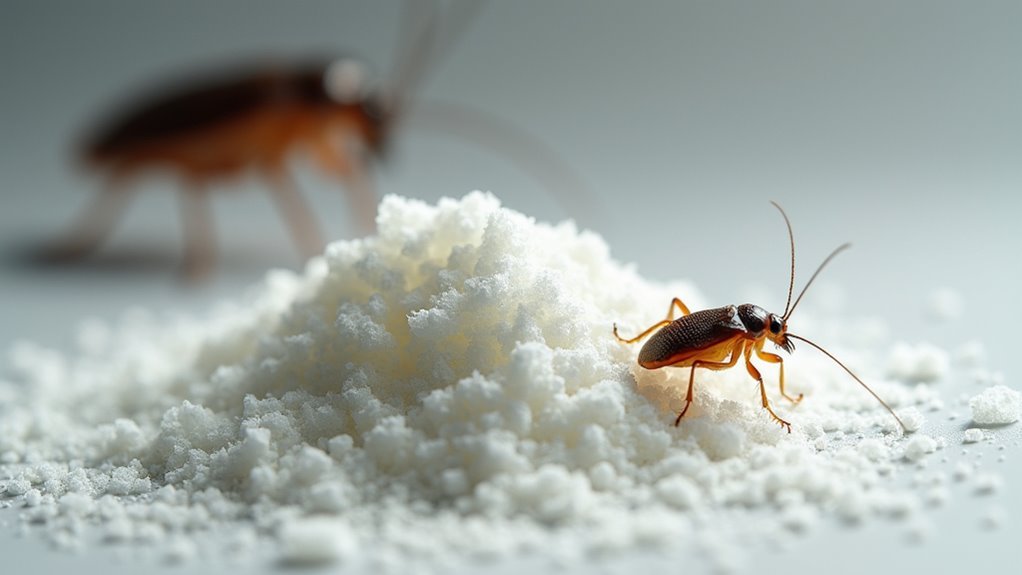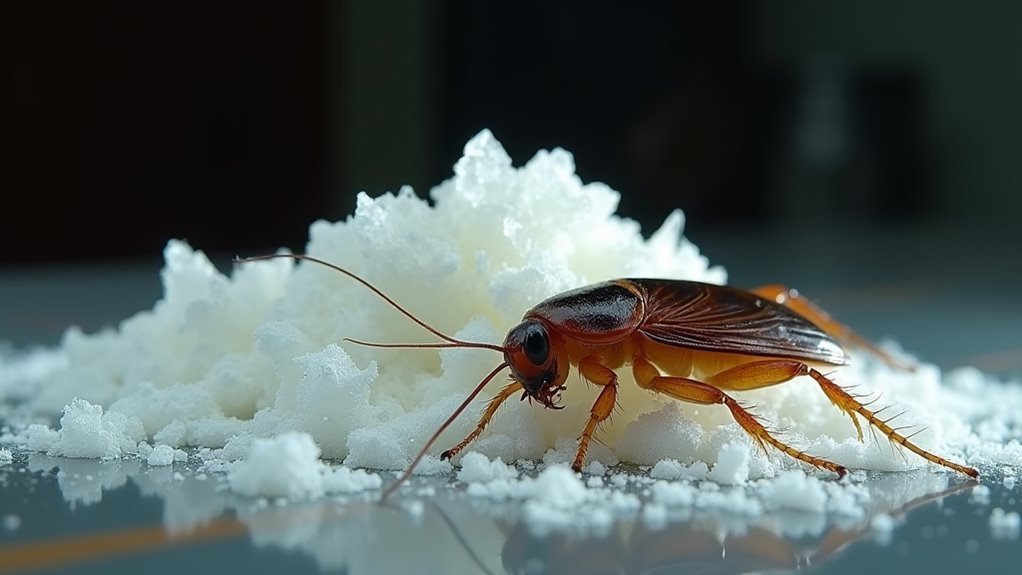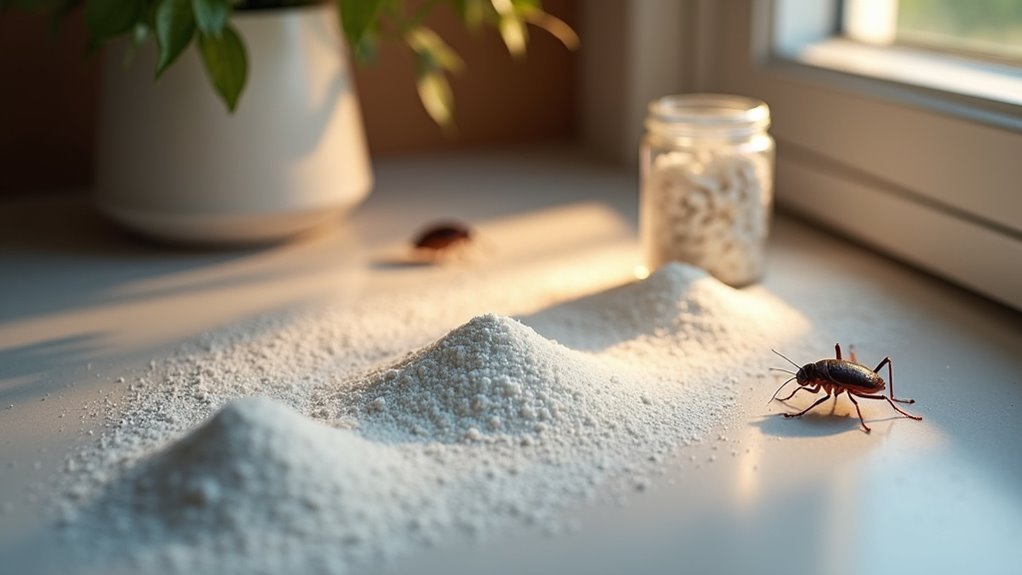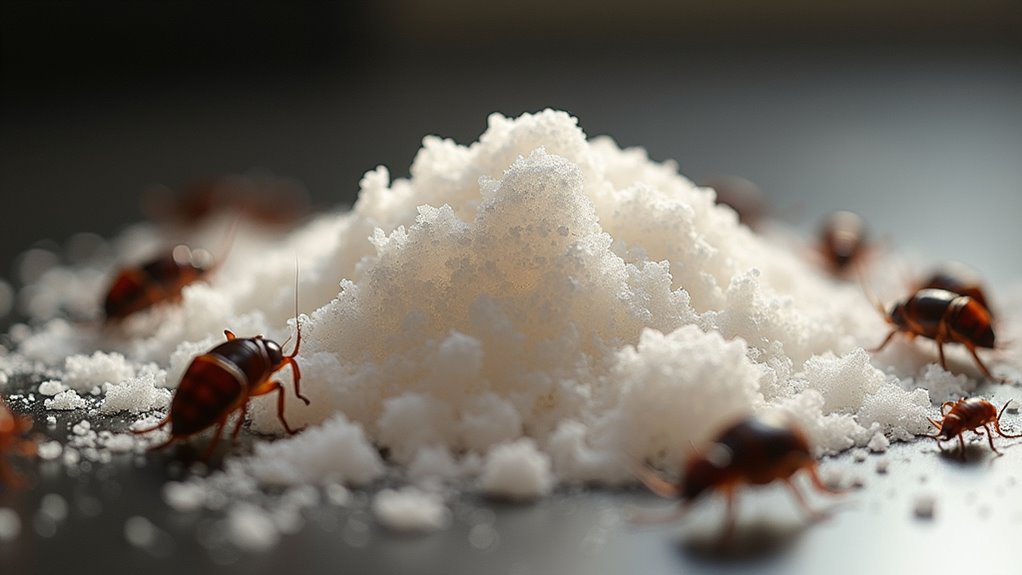Boric acid effectively exterminates cockroaches because it attacks their bodies through a deadly two-pronged assault. When roaches walk through boric acid dust, particles stick to their bodies and get ingested during their natural grooming behavior. The acid then disrupts their nervous system, causing paralysis, while simultaneously damaging their protective exoskeleton, leading to severe dehydration. This dual mechanism guarantees roaches can’t escape or seek water, resulting in death within 72 hours and preventing resistance development through continued exposure.
The Science Behind Boric Acid’s Lethal Impact on Cockroaches

When cockroaches encounter boric acid, they’re unknowingly sealing their fate through a deadly multi-stage process that targets their most vulnerable biological systems.
As roaches walk through the powder, particles cling to their bodies and exoskeletons. During their natural grooming behavior, they ingest these toxic particles, triggering neurological disruption that leads to paralysis within 72 hours.
The boric acid to kill mechanism works through dual destruction: it damages their protective exoskeleton while simultaneously attacking their nervous system.
This damage causes severe dehydration, accelerating death considerably.
What makes this method exceptional for killing cockroaches is its secondary contamination effect. Infected roaches carry the poison back to their nests, spreading it throughout the colony.
This thorough approach guarantees effective cockroach control across entire populations, making boric acid remarkably lethal.
How Roaches Encounter and Ingest Boric Acid During Grooming
As cockroaches scuttle across surfaces dusted with boric acid, the fine powder’s electrostatic charge causes particles to cling stubbornly to their legs, antennae, and body segments.
When you apply boric acid strategically in areas where roaches come to forage, you’re leveraging their compulsive grooming behavior against them.
The contamination process follows a deadly sequence:
- Contact – Roaches pick up boric acid particles while traversing treated surfaces
- Grooming – They meticulously clean themselves, ingesting boric acid clinging to their bodies
- Contamination – Infected roaches return to nests, spreading particles to other colony members
This grooming ritual becomes their downfall.
Ingesting boric acid disrupts their nervous system while simultaneously damaging their protective exoskeleton, causing fatal dehydration and paralysis throughout the entire population.
Nervous System Disruption and Dehydration Effects

Once ingested during grooming, boric acid launches a devastating two-pronged attack on the cockroach’s biology.
The first assault targets the roach’s nervous system, causing severe nervous system disruption that interferes with normal brain function and motor control. You’ll notice affected cockroaches becoming disoriented and losing coordination as the boric acid overwhelms their neural pathways, eventually leading to complete paralysis.
Boric acid overwhelms cockroach neural pathways, causing disorientation, loss of coordination, and eventual complete paralysis within hours of exposure.
Simultaneously, boric acid damages the cockroach’s protective exoskeleton, triggering rapid dehydration.
This dual mechanism creates a lethal combination where the roach can’t escape or seek water due to nervous system impairment while simultaneously losing vital body fluids. The relentless progression of both nervous system disruption and dehydration guarantees the cockroach’s death within approximately 72 hours of initial boric acid exposure.
Why Cockroaches Cannot Develop Resistance to Boric Acid
This lethal effectiveness of boric acid becomes even more significant when you consider that cockroaches can’t develop resistance to it.
Unlike other pesticides that lose effectiveness over time, boric acid maintains its deadly impact through mechanisms that prevent genetic adaptation.
Here’s why roaches can’t build resistance to boric acid:
- Non-repellent nature – Cockroaches unknowingly walk through it without detecting danger, providing no opportunity to learn avoidance behaviors.
- Dual-action killing method – It disrupts their nervous system while causing dehydration simultaneously, making biological adaptation impossible.
- Consistent mode of action – The compound works the same way every time, regardless of cockroach species or environment.
Research confirms that long-term boric acid use shows no reduced efficacy, making it a reliable pest control solution you can trust.
Strategic Placement Techniques for Maximum Roach Elimination

Strategic placement transforms boric acid from a simple powder into a targeted weapon against cockroach infestations.
You’ll maximize effectiveness by focusing on high-traffic areas where roach droppings indicate active pathways. Apply boric acid powder along baseboards, under sinks, and behind appliances where roaches frequently travel.
Target cracks and crevices, wall voids, and other hidden spots where roaches hide during daylight hours. These secluded areas become deadly traps when treated properly.
Never apply boric acid on food preparation surfaces to protect your family and pets from accidental ingestion.
Create an irresistible bait by mixing one part sugar with three parts boric acid. The sugar masks boric acid’s bitter taste, encouraging consumption during grooming.
Regularly inspect treated areas and reapply as needed, especially in humid conditions where effectiveness diminishes over time.
Creating Effective Boric Acid Bait Mixtures and Recipes
While proper placement sets the foundation for roach control, mixing effective baits determines whether cockroaches will actually consume enough boric acid to eliminate the colony.
You’ll need proper ratios and attractive ingredients for getting rid of these persistent pests.
Here are three proven bait mixture recipes:
- Sugar-Based Recipe: Combine one part sugar with three parts boric acid for a basic yet effective mixture.
- Peanut Butter Blend: Mix boric acid with peanut butter or honey for enhanced palatability.
- Moisture Protection: Keep mixtures dry and away from humidity to maintain potency.
Use boric acid mixtures on paper plates positioned out of children’s and pets’ reach.
Regular monitoring and replenishment guarantees continuous effectiveness as roaches consume the bait.
Timeline of Roach Death After Boric Acid Exposure
Once roaches consume your boric acid bait, you’ll typically see results within 72 hours as the compound disrupts their nervous system and causes fatal dehydration.
The timeline of death varies depending on how much boric acid each roach ingests and their individual size and health condition. When roaches walk through the powder, they’ll groom themselves and accidentally consume the particles, sealing their fate.
In severe roach infestation cases, you’ll witness a domino effect where dying roaches contaminate others in their nest, amplifying the treatment’s effectiveness.
However, don’t expect immediate results—patience is key. You’ll need to monitor your property carefully and may require additional boric acid applications to completely eliminate the entire population, especially in larger infestations.
Advantages of Boric Acid Over Commercial Pesticides
You’ll save considerably more money choosing boric acid over commercial pesticides since it costs less upfront and doesn’t require frequent reapplication.
Unlike expensive pest control products that cockroaches eventually develop immunity against, boric acid maintains its killing power indefinitely without forcing you to upgrade to stronger formulations.
This means you’re investing in a one-time solution that won’t lose effectiveness or drain your wallet with repeated purchases.
Cost-Effective Long-Term Solution
Three compelling advantages make boric acid a superior choice over commercial pesticides for roach control.
You’ll discover considerable savings when choosing this cost-effective alternative to expensive professional pest control services.
Here’s why boric acid delivers unmatched value:
- Fraction of the Cost – You’ll pay considerably less than commercial pesticides while achieving comparable results, making it budget-friendly for any homeowner.
- Extended Effectiveness – It maintains potency when dry, providing months of continuous protection without requiring frequent reapplications or additional purchases.
- No Special Equipment – You won’t need costly application tools or professional training, unlike many commercial solutions that require specialized equipment.
This combination of affordability and longevity makes boric acid an intelligent investment for sustainable roach elimination.
No Resistance Development
Beyond the financial benefits, boric acid offers a distinct advantage that commercial pesticides simply can’t match: cockroaches won’t develop resistance to it. For decades, boric acid has maintained its effectiveness against roaches without any documented resistance development, making it your most reliable choice for effective extermination.
Unlike commercial pesticides that trigger evolutionary adaptations in pest populations, boric acid’s unique nervous system targeting prevents this problem entirely. You won’t face the frustrating cycle of switching products as roaches adapt.
Since boric acid doesn’t repel cockroaches, they’ll continue encountering and ingesting it without developing avoidance behaviors. This means you can use boric acid consistently as both treatment and prevention, maintaining long-term control without worrying about diminished effectiveness over time.
Safety Considerations When Using Boric Acid Around Homes
While boric acid presents a relatively safe option for roach control, you’ll need to exercise proper caution to protect your family and pets from potential health risks.
Though considered low-toxicity, improper handling can lead to serious safety considerations requiring immediate attention.
Essential Safety Measures:
- Strategic Placement – Never apply boric acid on countertops or food preparation areas where children and pets can access it easily.
- Emergency Response – Contact poison control immediately if humans accidentally ingest boric acid, or seek veterinary attention if pets show poisoning symptoms.
- Proper Application Techniques – Target high-traffic roach areas while storing unused product securely away from family members.
These precautions guarantee you’ll effectively eliminate roaches without compromising household safety.
Troubleshooting Common Boric Acid Application Mistakes
Even when you’re using boric acid correctly, several common mistakes can sabotage your roach control efforts.
You might be placing the powder in the wrong locations, applying too much product, or exposing it to moisture without realizing these errors are reducing its effectiveness.
Understanding these frequent missteps will help you maximize your boric acid treatment and achieve better results against roach infestations.
Incorrect Placement Areas
Although boric acid can be highly effective against roaches, placing it in the wrong locations will sabotage your extermination efforts. Proper placement is essential for successful control, and certain areas should be completely avoided to maintain effectiveness and safety.
Never apply boric acid in these incorrect locations:
- Food preparation surfaces and countertops – This creates contamination risks and removes the product from roach pathways where it’s actually needed.
- High-moisture areas like bathrooms – Humidity causes clumping and reduces the powder’s potency, making it ineffective against your roach problem.
- Visible, high-traffic areas – People will disturb or clean away the boric acid before it can work, wasting your efforts and reducing long-term effectiveness against the infestation.
Using Too Much
One fundamental mistake homeowners make involves applying excessive amounts of boric acid, thinking more powder means faster results.
However, over-application creates thick layers that prevent roaches from walking through and effectively ingesting the treatment. When you pile on too much powder, roaches avoid crossing these areas entirely instead of picking up particles on their legs and bodies for later grooming and consumption.
Excessive boric acid in high-traffic zones becomes counterproductive, deterring insects rather than attracting them. You’ll also waste product and create unnecessary cleanup work.
Additionally, thick applications clump together in humid conditions, making boric acid less effective. Apply thin, light dustings in targeted areas where roaches travel, ensuring they can’t avoid contact while moving through their regular pathways.
Moisture Exposure Problems
When moisture infiltrates your boric acid applications, you’re facing one of the most common reasons treatments fail against roaches.
Moisture exposure dissolves the powder, rendering it ineffective and forcing you into costly reapplications.
Here’s how to protect your boric acid from moisture damage:
- Choose dry locations – Apply boric acid away from sinks, bathrooms, and areas prone to dampness.
- Monitor humidity levels – Check treated areas regularly to determine when reapplications become necessary.
- Improve ventilation – Fix leaks and enhance airflow to maintain dry conditions.
High humidity environments greatly reduce your treatment’s longevity.
You’ll need more frequent reapplications in these conditions.
Frequently Asked Questions
Why Does Boric Acid Kill Roaches?
Boric acid kills roaches because when they walk through it, the powder sticks to their bodies. They’ll ingest it while grooming, disrupting their nervous system and damaging their exoskeleton, causing dehydration.
Why Is Boric Acid so Effective?
You’ll find boric acid extremely effective because roaches can’t develop resistance to it, it remains potent when dry for long-lasting control, and they inadvertently consume it while grooming themselves.
What Works Better Than Boric Acid for Roaches?
You’ll find insecticide sprays with fipronil work faster than boric acid for immediate knockdown. Bait stations prove more effective for large infestations, while professional pest control services deliver thorough elimination using combined treatments.
Can Roaches Become Resistant to Boric Acid?
You don’t need to worry about roaches developing resistance to boric acid. They haven’t shown any ability to adapt to its dehydrating effects or nervous system disruption mechanisms throughout decades of use.
In Summary
You’ve learned how boric acid’s unique mechanism makes it a powerful cockroach eliminator that roaches can’t develop resistance to. By understanding proper placement techniques and avoiding common mistakes, you’ll achieve maximum effectiveness. Remember to prioritize safety around children and pets while applying this proven solution. With patience and strategic application, you’ll see results within days as boric acid disrupts their nervous systems and causes fatal dehydration through their natural grooming behaviors.





Leave a Reply